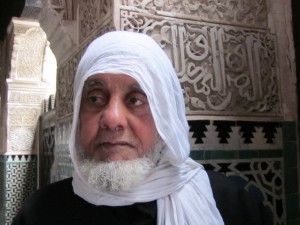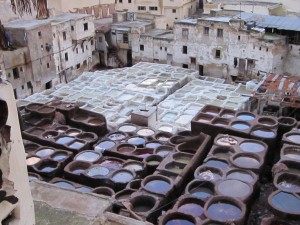On March 7th, we left Azrou for Fez in the early morning, stopping en route in Ifrane, a holiday town in the Middle Atlas region of Morocco. Ifrane, known as the “little Switzerland” of Morocco due to its European architecture, is popular during the summer because of its temperate climate. The town served as a Prisoner of War camp during WWII, and during our visit to the gardens we saw a lion sculpture that is rumoured to have been carved by an Italian prisoner during the war.
After taking a short walk around the many gardens in the town, we continued on to Fez. As we approached the outskirts of the city, we began noticing a strong military presence and a huge number of Moroccan flags on the roads coming into the city, and the inner city streets. Our driver, Mohamed, told us that King Mohamed the Sixth was visiting the city, for, what we later found out, the beginning of the construction of an expressway that would link the Fez-Oujda motorway to the Fez airport, and Fez proper.
Upon our arrival in Morocco one week beforehand, I think we were all surprised by how modern the roads and highways that linked the cities together were. However, if we compared that to the roads that we took to visit the small village near Azrou where volunteers were providing aid, there is a huge difference in quality and upkeep of these roads. While I understand that reducing the amount of time it takes to travel to the airport and the number of car accidents that occur on the motorways in Fez is important, it is imperative that the Moroccan government also reviews and improves the dirt roads that link small villages with local larger towns. We were unable to travel quickly along the road to the village due to potholes and mud, and this could definitely hamper the ability of ambulances and other rescue vehicles to arrive in time to help.
Our first stop in Fez was at the city council building, where we met with a representative of the Mayor, who spoke and answered our questions about immigration to and from Fez, and the impact of remittances on the city. He described the twelve centuries old Fez as the “cradle of Moroccan civilisation,” and the spiritual and cultural capital of Morocco. According to the representative, urbanisation is having a large impact on the city, with the arrival of at least 700 migrants per day spurring the creation of large shantytowns in the outskirts of Fez. He also spoke on the “brain drain” that he believes is depriving Morocco of its young intellectuals who are moving to Europe, North America and Australia in hopes of finding better jobs.
Following the meeting we dropped off our bags at the hotel before being taken on a tour through Fez’s medina (the old part of the city), by our guide Lotfi. We found that Fez’s world famous medina was even busier than that of Rabat, though we recognized a lot of the same goods that we had already seen previously.
We were lucky enough to be able to visit Al-Qarrawiyin, which was founded in 859 by Fatima Al-Fihri, the daughter of a wealthy Muslim merchant and is, reputedly, the oldest university in the world. Al-Qarrawiyin has served as both a mosque and a university since its foundation, and even now it remains a state university.
Our tour ended at the tannery, where we saw the pools of dye and other chemicals that prepare the leather that is used to make the leather products, such as the slippers, or “babouche,” that Morocco is famous for. We were given mint leaves to smell in order to hide the pungent odour of the chemicals.
After sampling the local cuisine, our tour guide Lotfi spoke to us about his own personal experiences dealing with immigration.
The next morning we hopped on the bus for the six-hour journey to Tetouan!
Kathleen



